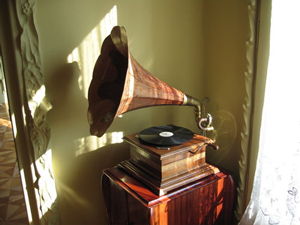My Fair Lady
By Alan Jay Lerner
HIGGINS’ [sic] study on Wimpole Street. It is a room on the first floor with one window . . . looking out on the street and double doors in the middle of the back wall. There is a balcony above them with stairs to one side leading up to it. There is another door on the balcony and the wall of the balcony is entirely covered with bookcases. Next to the door is a small table upon which there is a recording machine . . . .
When the lights go on, as they will in a moment, HIGGINS in the morning light is seen to be a robust, vital, appetizing sort of man of forty or thereabouts. He is of the energetic scientific type, heartily . . . interested in everything that can be studied as a scientific subject, and careless about himself and other people, including their feelings . . . but he is so entirely frank . . . that he remains likable even in his least reasonable moments . . . .
MRS. PEARCE
Mr. Higgins, are you there?
HIGGINS
What is it, Mrs. Pearce? (He turns down the volume of the machine)
MRS. PEARCE
A young woman wants to see you, sir.
HIGGINS
(Turning the machine off) A young woman! What does she want? (He switches on the light) Has she an interesting accent? (To PICKERING) Let’s have her up. Show her up, Mrs. Pearce.

Source: phono, robinhamman, Flickr
MRS. PEARCE
Very well, sir. It’s for you to say. (She goes out into the hall)
HIGGINS
This is rather a bit of luck. I’ll show you how I make records. We’ll set her talking; . . . and then we’ll get her on the phonograph so that you can [listen] as often as you like . . . .
MRS. PEARCE
(Returning) This is the young woman, sir.